Simon Schama meets Grayson Perry
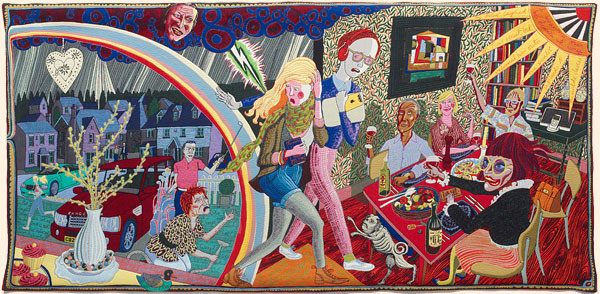
Simply sign up to the Life & Arts myFT Digest -- delivered directly to your inbox.
“You’ve gone all cuddly on us,” I say to Grayson Perry. I’d just come from the Royal Academy where his tapestry series The Vanity of Small Differences is occupying its own gallery in the Summer Exhibition. The room was chock full of happy attentiveness, smiles turning to chuckles as a celestial Jamie Oliver is spotted presiding over “The Expulsion from Number 8 Eden Close” – the garden where Mum hoovers the AstroTurf – and into the welcoming dinner party where the Extra Virgin stands to attention beside the bruschetta. I love this stuff, too, but something in me pines for the puke and the pogo, the acts of sensational unseemliness unfolding round the back of the gasworks that Perry magicked up on the pearly surface of his pots in the Turner Prize a decade ago. I can feel National Treasuredom coming over him with every stitch. Cuddly.
“But cuddly interests me,” he says, making a typically nimble end run round my mild reproach. For a terrible moment I see Claire Clever Clogs, Perry’s alter ego, turning Cuddly into a cutting-edge idea. Horrifying prospects unfold of academic departments of Cuddly Studies being founded; a new art magazine, Cute, devoted to Cuddly Theory, lying on the reception desk at white wine openings; monographs published bearing titles such as “Cuddlesome! Upholstery, Stuffed Animals, Bourgeois Regression and the Quest for the Comfort Zone in the Age of Austerity”. I snap out of the nightmare but I want my Essex yoof back with his serial killer sex maniacs. “Oh,” says Perry, “shockingness is such a cliché now – skulls, the tattooed street artist, the piercings – they’re from a different time. We’re all bohemians now; that roster of rebellious injury has gone mainstream, marketised. I’m interested in making stuff that feels uncomfortable to the art world, my little village, so being cuddly is interesting, especially since the art world likes to think of itself as so very avant-garde.”
A large piece of me wants Perry not to give a toss about the art world but I recognise that the vital originality of his work has always been nourished by taking the measure of its expectations and then confounding them. At art school in the early 1980s, around the time when Julian Schnabel's “cack-handedness” (as Perry calls it) in turning broken plates into images was celebrated, an influential tutor pontificated to students that “craft is dead”. This had the immediate effect of the young contrarian thinking, “Well, conservatism suddenly looks radical” and going off and making “precious things”: a bronze Bible cover, a crown. When he told his mates, who were all off making films, that what he was committing was …pottery …after the stunned silence they entirely got it. Yes, right, Pottery! If he says so! Forget about Marcel Duchamp, wheel on Clarice Cliff.
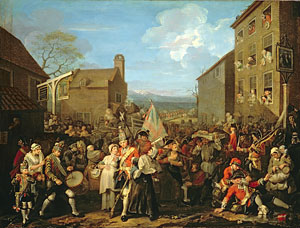
But it was pottery with a difference: a startling dissociation between the form – delicate, elegant, classical, smooth – and the surface – paintings that were none of those things. Decorated ceramics, of course, have long carried stories but Perry’s were from an entirely different universe than that of willow-pattern pagodas and nightingales. Instead, Perry had the Hogarthian ant-heap swarm over them, overpopulated, chaotic, febrile; little figures up to no good doing what humans will do, the nice and the nasty bits, tea and tits. In one fell swoop he had brought together exactly the two qualities classical modernism wanted to banish from art: craft and socially saturated story that, as the artist whose first exhibition had been the results of a £2-a-term night school course well knew, people happened to love the most. The theology of modernism, with its contempt for material making (hence the complacent sanctification of the ready-made) and its hostility to narrative meaning had passed the people by, and wicked Grayson Perry, who covers the entire human waterfront without the slightest trait of poncey condescension, sensed they wanted them back and duly, brilliantly, obliged.
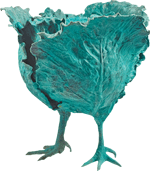
Helen Chislett celebrates the strange oeuvre of François Xavier and Claude Lalanne in special supplement. Plus the Duke of Devonshire on turning Chatsworth House into a destination for contemporary art lovers, Georgina Adam’s regular art market column, and more.
In this way Perry is a throwback to the long centuries when art and craft were synonymous: when kunst and arte presupposed the skill of making. His intuition that the visibility of the craft process (even when it passes through digital manipulation) is intrinsic to its appreciation, can be read in much of the happiness of viewers in the Royal Academy who do a little dance of close-inspection approach and wide-angle retreat when they look at the weave of colour and animation. This matters a lot to Perry, not so much from any sense of artisanal superiority but because the process becomes a cumulative, organic, endless source of revisions, adjustments and alterations, an interaction with the material that he describes as “call and response”.
Conversely, he despises the kind of contemporary art that says to itself, “I’ve just had an idea, now I’ll put it out to tender.” The result is, all too often, “flat, procedural, awful”. When he first beheld Jeff Koons at the Saatchi Gallery, “I thought this is so cynical, deadpan. I despaired of western culture. But when it sunk in that that was the point I thought, ‘Brilliant’. I was in love with its awfulness.”
Even though he has to leave it to digitisers in Madrid to translate his drawings into forms that can be woven into the final work, there’s nothing second-hand about Perry’s painstaking care with each and every detail, especially the colour that flashes through the Vanity series. There are only 24 basic colours available in the digital palette so he takes infinite care to mix them for exactly the right shades that are needed to nail the habitat and, of course, the costume of the social tribes who feature in his story. By their kit shall ye know them, so Perry, who is his own wardrobe mistress – and participates in a print course for fashion students at St Martins – has exactly the right, ghastly strawberry yoghurt pink for grandma’s surgical stocking; the perfectly decrepit buff, red and beige check suiting covering the body of the country toff “at bay” and the single Paul Smith sock of the dead anti-hero of the series, horizontally striped in powder blue and pink.
All this is in the service of the kind of social storytelling of which he is the contemporary master and which he delivers with the warmest-hearted of sensibilities. He laughs at the journalist who interviewed him for Le Monde, who thought that the picture he delivered of modern Britain from “The Agony in the Car Park” to the vainglory of the Oliver-esque kitchen table was “bleak”. Perry is a shrewd psycho-ethnographer of the consumer tribes of modern Britain but one sympathetic to its rich vein of human comedy exactly because he recognises so much of their foibles in himself. “Whenever I find myself bristling at something, I ask myself, ‘Is there a bit of me in the person I am not liking? And the answer is, ‘Yes, totally.’ Oh, I am so part of the aching cycle of self-awareness and self-hatred: the need for individuation and the equal need for belonging. I want to be a tribe of one yet have everybody in it.”
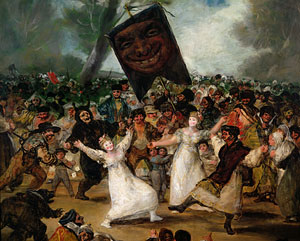
All these qualities connect, as he knows, Grayson Perry with the kind of vernacular art that began in the northern European renaissance, glowing with the new brilliance of oil painting, invented in Flanders where Perry gets his tapestries woven, and which drew on textile craft – dyeing and weaving – for the appeal of its pictures. (There’s a sly, mirroring allusion to van Eyck’s Arnolfini wedding couple in one of the tapestries.) Flemish and Dutch painting was intensely material, revelling in the texture of the stuff that piled up in their early form of consumer culture: its food, clothes, the fixtures and fittings of bourgeois life. And that art did something else as well, which set it aside from the rigorous fixed-point perspective of Italian classicism: it encompassed an entire social universe with an omnivorous appetite for all human types. Avercamp’s skating scenes and Rembrandt’s most socially encyclopedic etchings such as “The Hundred Guilder Print” or “St John the Baptist Preaching”, with their wailing babies, gnarly beggars and crapping dogs are what made possible Hogarth, Goya, the painters of Victorian crowd scenes, such as William Powell Frith (for whom Perry has a soft spot), LS Lowry and Grayson Perry.
Making room for all this social theatre, though, had certain formal implications for the design of the picture. Because European painting began as devotional art, everything about its power needed to be concentrated on the figures embodying Christian salvation: the Virgin, the Passion of Christ or the martyrs of Saints. It was, both institutionally and pictorially, centralised art, though, of course, it accommodated infinite numbers of bit players in various attitudes of reverence or obtuse infamy. But the Reformation decentred art as it did its theology. Pieter Bruegel the Elder, though a Catholic, almost made a fetish of minimising the figures of Christ or St John the Baptist, needing to be sought out amid the crowd. Matters of scale between Saviour and the saved (or the damned) were adjusted to this new multitudinous pluralism. And when, in the Protestant Dutch Republic, the market and civic patronage largely replaced court and church as the arbiters of taste, the object of enthralment became the entire society, sentimentally and mythically gathered in one of those kaleidoscopic assemblies of social types. Art became about togetherness even when it was a social lie.
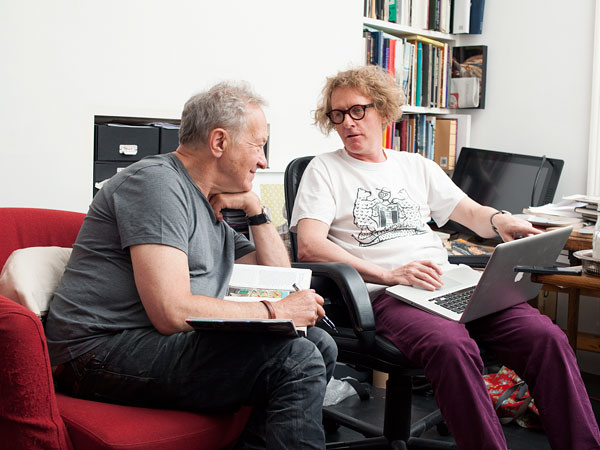
It was not, however, an uncritical art. Many of the scenes of low-lives debauched in taverns, or Jan Steen’s “disorderly households” pretended at least to have a moralising tinge, even as those who bought and enjoyed them recognised, just like Perry, versions of their own naughtiness in the subjects they were supposed to deplore. This art – profuse, uncentred, comic – was edging towards satire but it was only when, yes, FT readers, a financial bubble exploded in the faces of the punters and the bankers that it took off into outright polemical attack. In the prints attacking the South Sea Company stock debacle, every kind of sucker and con were gathered together in allegories of financial crime and stupidity: the greedy and the rich; the credulous and the mischievous. The market that had brought them low and the visual satires that documented the folly were called the “Windhandel”: the trade in thin air. Does this sound familiar?
Perry’s paragon, or the “lodestone of British art” as he affectionately calls him, is William Hogarth, who cut his teeth on engraving signs and social cards but also on satires of the South Sea Bubble. Whether Hogarth was doing one of his “Modern Moral Subject” series such as “A Harlot’s Progress”, which made his name, or “A Rake’s Progress”, on which Perry’s series is loosely based, or single-frame scenes of carnival mayhem like “The March to Finchley”, he could only accommodate all the heaving action by being indifferent to the hardcore classical rules that deployed just this and that figure in carefully calibrated deep space. Instead, Hogarth’s equation of the rococo “serpentine line” as the “Line of Beauty” became not just an aesthetic choice; it was a formal means to accommodate the line of anecdote and moral narrative; wheeling and enclosing capsules of story that ribbon through the image.
You can see something of this in the “Adoration of the Cage Fighters”, the first in Perry’s tapestries. And he loves this indifference to hardcore classicism, reckons it a signal characteristic of British art, a V-sign stuck in the face of academic draftsmanship. “I never look at Hogarth and think, ‘Wow, what an amazing composition.’ He’s competent but I respect his plonkiness, his refusal to be sucked away in the effete aestheticism of the continentals.” Perry, my fellow Essex boy, warms to this tune. “We are all so desperate to hunt for Englishness, to try and connect to the European renaissance, that we are missing our own brilliant contribution to world culture, which is to say, “Oh come off it!” That’s what we do, hold complex ideas and manage to be ambiguous in a humane way, to celebrate humanity while at the same time satirising it, that’s what makes us English.”
It’s this full English breakfast idea of English art – rich, meaty, abundant and gloriously greasy with the social fry-up – that makes Grayson Perry’s work and the hard-worked craftiness with which he serves it up so irresistible. But though the result has a kind of pub-happy breeziness, it is, in fact, the result of Perry being so anchored in the long art tradition he loves and which nourishes him. The Vanity tapestries draw on, inter alia, Giovanni Bellini, Crivelli, Masaccio, and Gainsborough but in a considered not a grab-bag way. At a college degree show he found himself dismayed by the emptiness of some of the work, the “half-arsed references”, the “snatching at the shadow of ‘now”. He worries that vast amounts of money, uninformed by looking at the long tradition and cynically advised to snap up the Famous Brands, are just inviting the explosion of an evermore bloated inventory of vacuous dreck. But, then, perhaps all Perry needs to do by way of correction is to continue to dish up his complicated, teasing, brilliantly fashioned riffs on the human comedy, and the best of the students will see just how much it takes to make strong, enduring, contemporary art.
Simon Schama is an FT contributing editor
The Arts Council Collection’s national tour of Grayson Perry’s ‘The Vanity of Small Differences’ starts at Sunderland Museum. www.artscouncil collection.org.uk; it will also be toured internationally by the British Council
For more tapestries, see Collecting supplement; Jackie Wullschlager on LS Lowry
Comments